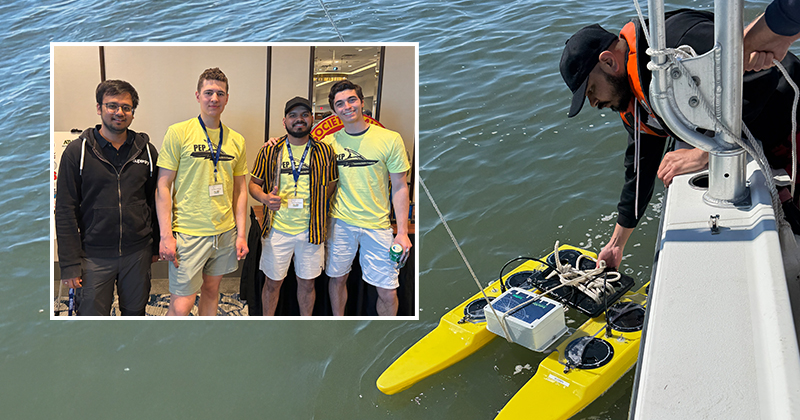


UD team shines in national naval competition
Photos courtesy of Team Delaware Dynamos | Photo illustration by Joy Smoker August 13, 2025
A team of undergraduate and graduate engineering students designs an electric vessel and earns a fast finish
In a bold leap into uncharted territory, a group of undergraduate and graduate engineering students from the University of Delaware built and raced an electric, autonomous vessel without any prior experience in naval engineering. Guided by professors Herbert Tanner of the Department of Mechanical Engineering, and Arthur Trembanis of the School of Marine Science and Policy, Team Delaware Dynamos transformed a donated hull into a competition-ready vessel in just five months.
They worked out of Spencer Lab’s Design Studio, a cornerstone of hands-on engineering education at UD. With tools and materials from the Fab Lab, a Design Studio makerspace featuring 3D printers, laser cutters and other advanced equipment, the team filled a modest lab space with sketches, circuits, fiberglass and the hum of 3D printers. Outside the lab, they tested their creation in the Delaware Basin with help from Trembanis’ marine science team at UD’s Lewes campus.
“Budget constraints pushed us to be creative,” said undergraduate mechanical engineering student Alec Klarmann. “We recycled components, leaned on open-source tools and solved technical failures as they came up. It wasn’t easy, but that process taught us more than any textbook could.”
The team’s seven-foot vessel was built using lightweight composites and retrofitted with electric propulsion and autonomous navigation capabilities. They poured hundreds of hours into debugging software, waterproofing electronics and refining the hull’s design to account for hydrodynamic drag.
Building a boat on a budget
For Rushabh Dhoke, a robotics graduate student and the team lead, the journey was a testament to what students can accomplish when given the tools and trust to innovate.
“When Professor Tanner first mentioned the ASNE PEP competition to me, I was instantly fired up,” he said. “We had no previous experience in naval robotics, but we believed that a small, determined team could go far with the right planning and perseverance.”
Delaware Dynamos team launches electric, autonomous surface vehicle: https://capture.udel.edu/media/1_jh7hjq9a/
Dhoke shared an example of that planning. The Dynamos replaced the boat’s original metal frame with a lighter polycarbonate version, increasing payload capacity without sacrificing strength. They further reduced weight by fabricating small components on 3D printers.
“Naval robotics isn’t just putting a drone on water,” said Andrew Bryceland, a robotics graduate student who had worked mostly with ground and aerial vehicles before joining the team. “You’re dealing with buoyancy, water resistance, battery management and power distribution in a totally different way. It’s a whole new engineering language.”
Those lessons culminated at the American Society of Naval Engineers (ASNE), Promoting Electric Propulsion (PEP) competition, held on a river in Virginia and attended by top engineering programs from across the country. ASNE is a nonprofit that supports naval and maritime professionals.
The Dynamos qualified on Day 1 and made it over 1.5 miles of the 2-mile timed race on Day 2 before a power connector failed, halting the run just shy of the finish. Even with the breakdown, their performance earned a top-10 finish for fastest time, an impressive feat for a first-time team with limited resources.
“Missing the finish due to a breakdown was tough,” said Shubham Shah, a robotics graduate student. “But it taught us the importance of attention to detail and being able to adapt quickly. That kind of in-the-moment troubleshooting is what makes this field so exciting.”
Setting a course for what comes next
The experience has already sparked momentum for future work in marine robotics at UD. The Dynamos have been invited to showcase their vessel at the Navy’s 250th Anniversary Innovation Pavilion in Philadelphia this October, where they’ll demonstrate both remote-controlled and autonomous navigation, and highlight the boat’s ability to collect real-time environmental data.
“We’ve proven what a small, motivated team can do,” said Jared Wierzbicki, an honors student in mechanical engineering. “I’m excited to lead the charge again and keep raising the bar for UD in naval engineering.”
While their debut may have ended just short of the finish line, the Dynamos crossed a far more meaningful milestone: launching a new wave of student-led, hands-on innovation in marine systems, and charting a course for what comes next.
For Klarmann, the competition sparked a passion for solving tough engineering problems under real-world constraints, an interest he hopes to pursue in the aerospace and defense industry. Wierzbicki discovered the value of adaptability, learning to think on the fly and staying focused under pressure — skills he’s already applying in his internship at dsm-firmenich and plans to carry into future work in robotics or naval architecture.
Others were drawn deeper into marine systems. Shah emerged with a sharper vision for advancing open-source autonomy and leading longer autonomous vehicle deployments in the field. Bryceland joined the team to combine his interests in the ocean and robotics and plans to apply those skills to the marine sector.
“The competition taught me how to lead under pressure, adapt quickly and think through every detail because even a small mistake can have big consequences,” Dhoke said. “I gained hands-on experience in marine robotics and learned that setbacks are just opportunities to improve and build something better next time.”
Contact Us
Have a UDaily story idea?
Contact us at ocm@udel.edu
Members of the press
Contact us at 302-831-NEWS or visit the Media Relations website

